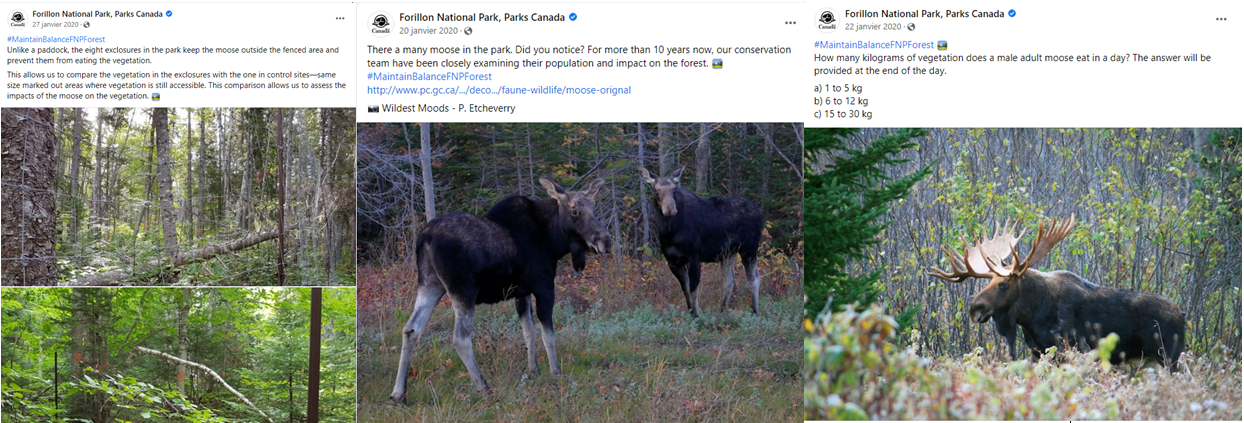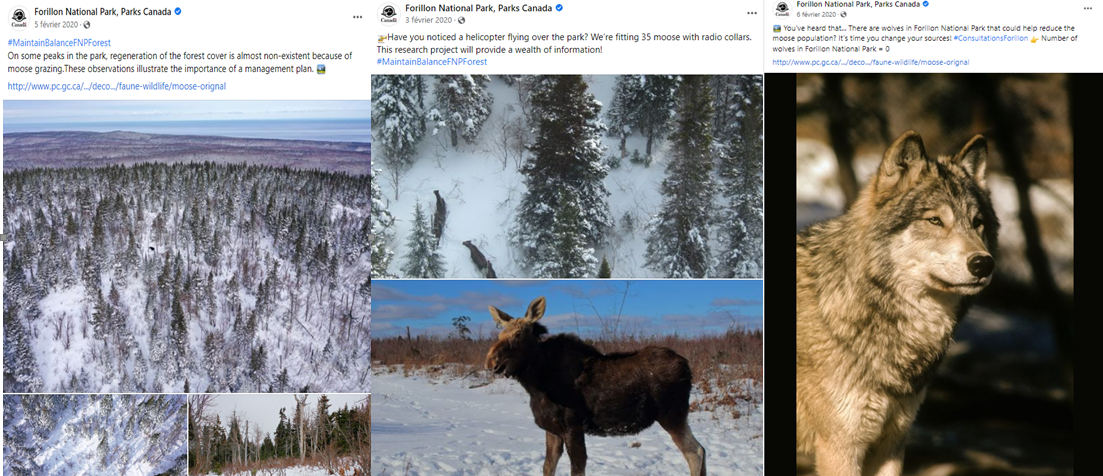
Consultation Report for the Renewal of the Forillon National Park Management Plan
Forillon National Park
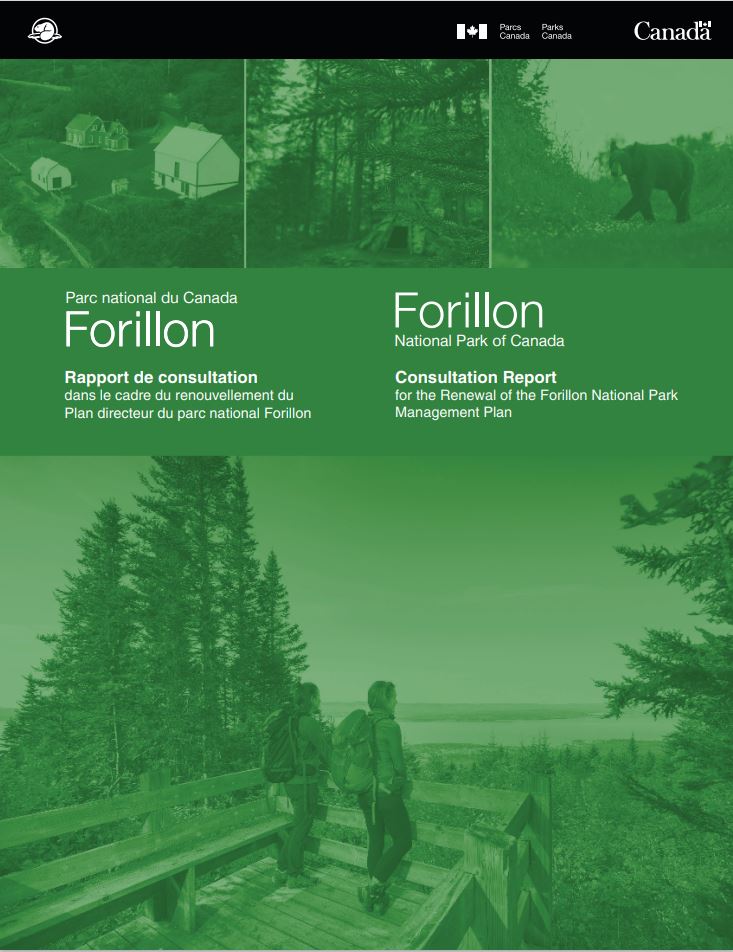
Table des matières
- Vision elements
- Key strategy 1 Achieving a vision together
- Key strategy 2 Fostering an evolving and healthy natural environment
- Key strategy 3 Protecting and enhancing a unique cultural heritage
- Key strategy 4 Making the park a top destination thanks to its rich natural and cultural assets
- Specific sectors
- Consultations with the Micmac Nation of Gespeg
- Conclusion
- Next steps
- Appendix 1 - Tables Consultation Report on the Forillon National Park - Management Plan
- Appendix 2 - Overview of communication activities - Management Plan for the overabundant moose population, Forillon National Park
Introduction
The new 2022 Forillon National Park Management Plan will guide management actions and decisions and will serve as a key tool to mobilize partners and the public. The strategic document presents a long-term vision for the park and includes achievable short- and medium-term objectives as well as targets to measure the achievement of expected results. It is reviewed every 10 years, as required by the Canada National Parks Act.
The management team first conducted a State of the Park Assessment, which describes the current state of the park based on a number of indicators related to ecological integrity, cultural resources, external relations, Indigenous relations, visitor experience and built assets. Based on the results of this assessment and a review of the 2010 Management Plan, a vision for the next 10 years and four key strategies were presented in the Draft 2020 Forillon National Park Management Plan. This document was shared with the Micmac Nation of Gespeg, partners, stakeholders and the public as a starting point for consultations on the management plan.
Consultation process
Parks Canada began the process of renewing the Forillon National Park Management Plan by reviewing the State of the Park Assessment. Subsequently, a draft management plan was prepared and presented publicly in consultations. Consultation with Canadians is required by law and Parks Canada policy to obtain the views of Canadians, Canadian organizations and Indigenous peoples on the proposed management direction for the national park.
Selected approach
It was important for Forillon National Park managers to find a consultation format that would allow as many people as possible to express their thoughts. A variety of means were used: information and consultation meetings with targeted groups, open houses for the general public, online surveys and the creation of an email address dedicated to consultations for the submission of briefs.
Preparation
Since the beginning of the management plan renewal process, the Forillon National Park Advisory Board, made up of representatives from partner organizations, has been regularly informed of how it is progressing.
Various communication actions have also been taken to make interest groups and the public aware of the consultation process:
Public consultations
In early 2020, targeted information and consultation meetings were organized with different groups: the Association of Persons Expropriated from Forillon and their Descendants, elected officials of the City of Gaspé and the La Côte-de-Gaspé Regional County Municipality (RCM), the Forillon National Park Advisory Board and employees Meetings were held with the Micmac Nation of Gespeg a few times between fall 2020 and winter 2022. The detailed presentation of the draft management plan was followed by a question and comment period. More than 70 people were consulted in this way.
On February 12 and 13, 2020, the local community was invited to participate in two open houses, one in the Corte-Réal area, at the Micmac Nation of Gespeg community hall, and the other in L’Anse-au-Griffon, at the Centre culturel le Griffon. The format included themed table discussions facilitated by park staff. Participants could arrive whenever they liked and engage in discussions on topics that interested them. These open houses allowed about 100 people to ask questions or share their vision of the park’s development for the next 10 years.
To allow all Canadians to participate in the public consultations, an online survey was available from February 12 to March 15, 2020 at pc.gc.ca/forillon. The survey was also published on the Government of Canada’s consultation platform. The opinions of 274 respondents were recorded. Most of them came from Gaspé.
Finally, about 20 individuals or organizations chose to send their feedback or comments by mail or to the email address pc.consultations-forillon.pc@canada.ca.
What we heard
The comments collected show that participants are mostly receptive to the proposed vision elements and the four key strategies mentioned in the draft management plan. It was noted, however, that some of the main focuses presented were not unanimously supported. Several new proposals were also noted.
Please note that the tables in the appendix (Appendix 1 – Tables) were taken from the online survey with 274 respondents.
Vision elements
The new management plan will include a long-term vision describing aspirations for Forillon National Park for the next 15 to 20 years. The proposal as presented in the consultation document is as follows:
In 2030, Forillon National Park will continue to be recognized for the authenticity of its majestic natural and cultural landscape. With its towering cliffs, rich boreal forest and abundant marine and terrestrial wildlife, Forillon Park will remain a symbol of harmony between land and sea. The rich history of those who previously occupied the territory of the park, whether Indigenous, commercial or agricultural, will be recounted through the ruins and constructions from that period that have been preserved to testify to the harmony of human beings with the land. Gaspesians and visitors alike will enjoy following the park’s varied trails, taking in magnificent views, lounging on its beaches and sleeping to the sound of waves. Forillon Park will combine its efforts with those of local communities to promote it as a tourist destination not to be missed and to offer activities and services that will enhance visitor experience.
Appreciation for Forillon National Park will be enhanced by:
- Working in collaboration with the park’s communities.
- Telling the human history of Forillon, whose most significant witnesses will become an integrated product in the park’s programming.
- Incorporating Mi’kmaq culture and traditional knowledge into operations, the activities that are offered and decision making.
- Ensuring a constant balance between park use and resource protection, between quantity and quality.
- Facing the challenges of nature and climate change by implementing mitigation and adaptation measures in harmony with ecosystems.
- Improving the connectivity of the park’s species and ecosystems with the entire Gaspé region.
- Renewing infrastructure and the experiences offered to visitors to increase their satisfaction and sense of attachment.
Responses to the online survey question on this topic demonstrate a high level of agreement with this proposed vision. In fact, 83.21% of people said they somewhat or completely agreed with the proposed draft (see Table 1).
The comments received indicate that the parts of the vision that most appeal to respondents concern working with the local community, the presentation of human history, and the balance between park visitation and resource protection.
Key Strategy 1 – Achieving a vision together
This strategy is based on increased collaboration between Parks Canada and local communities and partners to promote the park. The mobilization and support of the Micmac Nation of Gespeg and all the different partners—notably the Association of Persons Expropriated from Forillon and their Descendants—will lead to more concerted park management.
Responses to this section of the online survey show that the majority of respondents consider each of the objectives targeted in Key Strategy 1 to be very important or important (see Table 2).
Objective 1.1 – Expropriated families and their descendants have the opportunity to contribute to developing and implementing projects in line with their interests
Among the comments received, we noted that the involvement of expropriated families is essential and that their wounds are still very present. Many people also voiced that it was important to them that the passes offer be extended to the 4th, 5th and 6th generations of expropriated persons, and others noted the importance of hiring them. Finally, the relevance of involving expropriated persons was questioned by some. One of the reasons provided was that the park should base management on current scientific data.
Objective 1.2 – The governance model established with the Micmac Nation of Gespeg makes it possible to integrate and reflect Mi’gmaq values and traditional knowledge in the management of Forillon National Park
As mentioned above, most people support this objective. Again, the comment was made that the park’s priority should be conservation, based on current scientific knowledge and environmental realities. The issue of the importance of recognizing expropriated persons and First Nations was raised.
Objective 1.3 – Education and outreach opportunities are optimized and reach Parks Canada’s target audiences, notably youth, raising awareness about park themes
This goal nearly reaches consensus with 98% support, according to the online survey (see Table 2). It seems very important to those who shared their opinion that the park continue—and even improve—its educational activities with young people, especially in day camps and schools, at all levels combined. However, some say that there are gaps in the number of activities organized with schools in the English-speaking network.
In addition, education must be available not only within the park, but also outside its borders. These efforts should help educate young people about their history, wildlife, and physical activity, among other things.
“Young people are our future, so education and awareness for this audience must be a priority.”
According to several participants in the consultations, efforts to raise awareness among the general public and visitors about what behaviours to adopt towards wildlife must also continue. Showcasing or promoting animal documentaries made in the park was suggested.
Objective 1.4 – There is increased coverage of Forillon National Park in the media and promotional campaigns in Gaspésie
While the majority of online survey respondents agreed with the plan to increase the park’s communication efforts, a few others felt that promotional campaigns were sufficient. Others still questioned this objective, claiming that bringing in more and more visitors is harmful to ecosystems.
It was also mentioned a few times that the park should be promoted year-round to encourage people to visit at times other than summer. It was also suggested that the marketing plan be developed in collaboration with local stakeholders, that concessionaires’ activities be better communicated and that sustainable environmental strategies be put forward, for example, by promoting the idea of coming by public transit.
Objective 1.5 – Local communities and partners have a greater sense of ownership over the park
This objective caused many people to voice the importance for the park to actively and directly involve the local community (cultural and community organizations, tourism industry, businesses, population, etc.) at different levels. Some praised the park for its openness in this sense, while others said there was room for improvement. The latter criticized, for example, the park’s administrative structure, which sometimes seems rigid and makes it difficult to maintain a dialogue or carry out joint projects. Respondents also pointed out that the English-speaking community should not be overlooked. At the other end of the spectrum, a few people said that they would prefer the park to engage in as few collaborations as possible to avoid conflicts of interest.
“You went from working in a vacuum to a wide-open approach.”
To foster a sense of ownership over the park, the idea of reducing access costs, even going so far as making it free for local residents, came up a few times.
Key Strategy 2 – Fostering an evolving and healthy natural environment
Preserving the ecological integrity of ecosystems is a top management priority. The draft management plan proposes paying particular attention to Forillon’s forest, which covers 95% of the park territory, and to the coastal marine environment, which is more vulnerable to the impacts of climate change.
The majority of online survey respondents indicated that each of the goals targeted in Key Strategy 2 were very important or important to them (see Table 3).
“It’s essential that we preserve the park to be able to enjoy its beauty.”
Objective 2.1 – Forest ecosystem health improves
Some participants shared the idea of opening up the park territory by creating wildlife corridors. Other comments received advocated for no human intervention to allow nature to regenerate on its own. Others demanded a return to trout fishing in the park’s freshwater streams and the right to harvest dead wood or cut down mature forest. We also noted concerns about the presence of coyotes and bears at the park’s perimeter.
Objective 2.2 – Moose overpopulation is under control
Of the proposed control measures, adjusting hunting patterns in the area around the park received the highest level of social acceptability at just over 76% (see Table 4).
That was followed by conservation hunting within the park, which nearly 60% of respondents agreed with. In their comments, those surveyed indicated they would like to see supervised hunting for conservation that is safe for the park’s various users. If this measure is adopted, some suggested that a portion of the meat harvested be distributed to local community organizations.
About 10 respondents mentioned that they were in favour of letting nature do its work, without human intervention. That is to say that they prefer that no moose population management measures be put in place.
“Be careful not go overboard with whatever methods are chosen, regardless of the selected option [...]. If something is set in motion, make sure it’s not irreversible.”
“If hunting is allowed in the park, it’s important that it doesn’t interfere with residents’ and tourists’ fall activities. In particular, residents should not feel threatened by any hunting activity taking place on the edge of their land.”
Note: Since the hyperabundant moose management plan uses a separate approach from the Forillon National Park Management Plan, a separate report on communication activities, which explains the process for public consultations as well as how they were prepared and carried out, has been included in Appendix 2 – Overview on communication activities, Management Plan for the overabundant moose, Forillon National Park.
Objective 2.3 – Conservation of species at risk is enhanced
This was the objective with the highest acceptance rate (96.67%) in the online survey for this Key Strategy (see Table 3). Some people wanted to qualify this by specifying that they were for the protection of endangered species, but not at the expense of predators.
Objective 2.4 – Ecosystems that have been disturbed by human activity are restored
A strong majority of consultation participants agreed with this objective. We were also encouraged to consider the known and suspected archaeological potential in the areas targeted for restoration.
Objective 2.5 – The latest climate change data is used to guide park management and operations
For many, the park should be a leader in adapting to climate change. People said they were satisfied with the restoration of the beach at Cap-des-Rosiers and with the work done at Penouille. Some people called for caution in taking action, since it is difficult to predict the effects of climate change, while others believe we should be more resilient to seeing ecosystems change.
Objective 2.6 – There is more recognition of conservation efforts and scientific advances made in Forillon National Park
Most people feel that it is important for the park to communicate more about the work being done in relation to conservation, interpretation panels, bird banding and various fun activities, for example. It was even recommended that the public be involved in collecting scientific data and that more projects with scientific and educational institutions be developed.
“It’s important to have things to help the public understand conservation efforts and the scientific advances made in Forillon. This might even motivate some people to take action and continue these efforts in their own way. This type of sharing is essential to make progress in the fight against and in adapting to climate change.”
Key Strategy 3 – Protecting and enhancing a unique cultural heritage
Parks Canada is committed to increasing knowledge about the many cultural resources, to better conserving them and to further communicating their heritage value with the support of regional partners. This strategy concerns buildings, objects, landscapes and archaeological resources. A specific management approach is planned for the Grande-Grave sector.
Responses to the online survey question regarding this key strategy show that the vast majority of respondents consider each of the targeted goals to be very important or important to them (see Table 5).
Objective 3.1 – The level of knowledge and the conservation conditions for collecting historic objects from Forillon are improved to ensure their long-term conservation
In addition to the large number of people who agreed with the objective of preserving historic objects, several of them urged that they be given more prominence. In addition, many comments were received regarding infrastructure, heritage buildings and cemeteries that should be preserved. Some urged the park to do a better job of maintaining them, and others would like to see more interior development of heritage houses for use as museums or accommodations. An even greater number of people mentioned that they would very much like to see the Cap-des-Rosiers lighthouse, located just outside the park boundary, become the property of Parks Canada to ensure its continued survival.
Another comment came up several times: repatriating Forillon artifacts currently stored in Québec City to the Musée de la Gaspésie. On the other hand, Parks Canada’s collections branch was also called upon to organize its database better. Finally, a few comments concerned the proper care of food and ornamental plants.
« Regarding expropriated families, the buildings and objects that bear witness to their way of life should be given more prominence. »
Objective 3.2 – The heritage value of cultural resources is better communicated to visitors and the general public
A few recommendations from consultation participants included more commemorative and interpretive signage near old settlement sites, and the use of Elders’ knowledge.
“I think that making the value of these cultural treasures known is one of the keys that will allow Forillon National Park to ensure their survival and long-term protection. People are more likely to protect what they like, and to like what they know.”
Objective 3.3 – The Micmac Nation of Gespeg and Parks Canada work together to conserve, protect and present Mi’gmaq culture and heritage
Most people agreed with this objective, including some who suggested that Mi’gmaq place names be incorporated into various locations in the park. However, for 18% of online survey respondents (see Table 5), collaboration with the Micmac Nation of Gespeg is not very or not at all important.
Objective 3.4 – Significant cultural landscapes are identified and preserved as a record of the park’s history
Maintaining Forillon’s landscapes is seen as a priority by a large majority of those consulted.
“Maintaining the landscape must be prioritized in the Grande-Grave sector. Those landscapes are the heart and sole of that area.”
Objective 3.5 – Archaeological resources are better identified, documented and protected.
This last objective of Key Strategy 3 was once again considered important to respondents. Carrying out an exhaustive archaeological potential study was even proposed, along with initiating large archaeological inventory campaigns on the whole peninsula.
Key Strategy 4 – Making the park a top destination thanks to its rich natural and cultural assets
Responses to this question of the online survey show that the majority of respondents consider each of the objectives targeted in Key Strategy 4 to be very important or important (see Table 6). Based on the comments received, however, it is clear that people do not want the development of visitor services to impact wildlife.
Objective 4.1 – Visitation is better distributed and managed to ensure a high-quality visitor experience
IThis is the objective with the most support in this strategy, according to the online survey (see Table 6). Several people noted that there were too many visitors in the summer and that they felt this was detrimental to traffic, ecosystems and visitor experience.
“I find it very important to work on lengthening the season to have a better distribution of visitation. It’s not as exciting to go to the park during the construction holiday.”
During consultations, a very large number of participants said they would like to see winter activities return to the way they were before 2012 and proposed other ideas to be developed, in collaboration with local and non-local organizations and businesses. These included more trails for cross-country skiing, snowshoeing and fatbiking, more open and heated service buildings, offering winter accommodations, more open parking lots, maintaining and enhancing the boundary line for snowmobilers, organizing events and activities, developing backcountry skiing, offering packages in partnership with the community, etc. They also suggested continuing to offer certain services and activities longer in the fall to adequately welcome European tourists and encourage Quebecers to travel in the fall.
Objective 4.2 – The interpretation program offered to visitors is renewed with a new interpretive plan that integrates natural, cultural and historical components as well as Indigenous knowledge
A few people asked that the existing interpretive signs be refreshed and that others be added in various locations, but also that there be more interpretive guides. The idea of organizing more interpretive activities, such as talks in collaboration with the Association of Persons Expropriated from Forillon and their Descendants and the Micmac Nation of Gespeg, was also proposed to promote human interaction. Finally, some questioned the part of this objective that deals with incorporating Indigenous knowledge into the interpretation program.
Objective 4.3 – The accommodation offer in the park is improved to meet the target clientele’s expectations
Many people would be delighted to see more accommodations in the park, as demand exceeds supply during summer months (campgrounds, ready-to-camp accommodations, backcountry camping, “glamping” sites, dormitories, etc.). Recent investments in developing the Ôasis were commended.
While this objective is considered important or very important by a majority, it is interesting to note that 20% of online survey respondents found it not very or not at all important to improve the accommodation offer in the park (see Table 6). Some of the comments received indicated that the park should focus on its primary mission: conservation. It was also suggested that nearby accommodations outside the park be promoted.
Objective 4.4 – Forillon is recognized for its diverse recreational activities and its range of related services
A large number of people have asked for new trails to be developed, both for hiking and biking. Various ideas for additional activities were put forward, including: diving, roller skating, kite surfing, sailboat tours, canoeing, seal watching, etc. It was also suggested that these activities be developed throughout the park, not only in Grande-Grave..
Objective 4.5 – Efforts to upgrade visitor facilities and park buildings continue, and their condition improves
Installing toilet blocks in a few strategic locations was suggested, along with enhancing the products available in stores. Several people also recommended improving signage. The issue of accessibility also came up a few times.
Specific sectors
In the draft management plan, two sectors were identified as needing a stronger management approach than the rest of the park, namely the Grande-Grave and Cap-Bon-Ami sectors. This kind of specific approach is warranted because of their rather unique management issues and their special significance to the public and local communities.
Responses to these questions in the online survey show that a strong majority of respondents consider each of the objectives targeted in this specific approach to be very important or important, confirming the relevance of such an approach for these sectors (see Tables 7 and 8).
Objective 1 – Developing infrastructures in the Cap-Bon-Ami sector (access road, parking lots, camping area) is reconsidered, taking into account the problem of coastal erosion, the unique character of the sector and the experience offered to visitors
Several respondents noted problems associated with heavy traffic to Cap-Bon-Ami during summer months. They proposed implementing a public transit system or parking improvements, for example. Concerning camping, it was suggested that sites be developed on the mountain side. Finally, a few people asked for more cultural and other activities to be organized in this sector.
Objective 2 – The physical integrity of heritage buildings and structures in Grande-Grave is improved to maintain their heritage value
Several comments advocated for the preservation of heritage buildings that are already being showcased, as well as the restoration of abandoned houses that are in poor condition. Participants in the consultations also insisted that these buildings be used for something afterwards. The wharf is an important infrastructure for them as well.
Objective 3 – The layout and accessibility of the entire Grande-Grave sector are redefined to ensure a safe and high-quality experience for visitors
Once again, traffic congestion during summer months was highlighted. People are divided between adjusting roads and parking lots to accommodate more vehicles and banning trailers, or even cars, in favour of a shuttle service. Some reiterated the importance of respecting the particular environment of this sector.
Consultations with the Micmac Nation of Gespeg
The elected representatives of the Micmac Nation of Gespeg took the time to formulate comments and concerns following the meetings held in November 2020 and April 2021. It should be noted that these points are in addition to the comments made by members of Mi’gmaq communities who were also able to express their views during public consultations in winter 2020.
Overall, the elected officials were in agreement with the proposals submitted in the draft management plan. The following points were raised:
Conclusion
The Forillon National Park management team is satisfied with the participation in the various consultation activities and the quality of the comments received. It was noted that there was consensus on the vast majority of the proposals contained in the draft management plan, especially with regard to the place of expropriated persons in park management and in presenting their history, the conservation of fauna and flora, as well as the development of activities and services offered year-round. On the other hand, the fact that the Government of Canada is working towards making progress in reconciliation and renewing relationships with Indigenous peoples is of concern to respondents with respect to space given to expropriated families. The consultations also made it possible to highlight the importance for participants that the park be involved in preserving the Cap-des-Rosiers lighthouse.
Next steps
All comments and proposals received were reviewed to determine what adjustments need to be made to the draft management plan to ensure that it reflects the concerns and interests expressed by participants.
The Forillon National Park Management Plan will be finalized based on the comments received. It was submitted to the Minister of Environment and Climate Change at the end of 2022 to be tabled in Canadian Parliament.
A review of how the management plan is being implemented will be conducted annually and made public to report on progress towards the objectives targeted in the plan.
Appendix 1 – Tables
Consultation Report on the Forillon National Park Management Plan
The following tables are taken from the online survey (274 respondents). The percentages presented here are based on the number of people who answered each question and not on the total number of survey respondents.
Table 1
To what extent do you agree with the proposed preliminary vision?
|
Choice |
Percentage |
Number |
|
Totally agree |
36.13% |
99 |
|
Somewhat agree |
47.08% |
129 |
|
Neutral |
8.76% |
24 |
|
Somewhat disagree |
5.47% |
15 |
|
Completely disagree |
2.55 % |
7 |
|
Total |
100% |
274 |
Table 2
How important are the following objectives of this strategy to you?
|
|
Very important |
Important |
Not very important |
Not at all important |
No opinion |
Total |
|
More involvement of expropriated families and their descendants in the management of the park |
50.61%
|
31.98%
|
14.57%
|
0.81%
|
2.02%
|
100%
|
|
Better integration of Mi’gmaq traditional values and knowledge into the management of the park |
35.89%
|
36.69%
|
16.94%
|
8.06%
|
2.42%
|
100%
|
|
More education and awareness opportunities, especially for youth |
61.20%
|
36.80%
|
2,00%
|
0.00%
|
0.00%
|
100%
|
|
An increased presence of Forillon National Park in the media and in promotional campaigns |
33.73%
|
44.58%
|
17.27%
|
3.61%
|
0.80%
|
100%
|
|
More partners involved in delivering Parks Canada’s mandate |
32.40%
|
47.20%
|
15.20%
|
2.40%
|
2.80%
|
100%
|
Table 3
How important are the following objectives of this second strategy to you?
|
|
Very important |
Important |
Not very important |
Not at all important |
No opinion |
Total |
|
A healthier forest ecosystem |
62.66%
|
31.12%
|
4.15%
|
0.41%
|
1.66%
|
100%
|
|
Progress in species at risk conservation |
69.17%
|
27.50%
|
1.25%
|
0.83%
|
1.25%
|
100%
|
|
Restoration of disrupted ecosystems |
59.41%
|
30.96%
|
6.28%
|
0.84%
|
2.51%
|
100%
|
|
Park management supplied with up-to-date climate change data |
58.16%
|
31.38%
|
6.28%
|
2.09%
|
2.09%
|
100%
|
|
Greater dissemination and recognition of the conservation efforts and scientific advances made in Forillon |
45.23%
|
44.81%
|
7.47%
|
0.83%
|
1.66%
|
100%
|
Table 4
To what extent would you agree with the implementation of the following means to control moose overpopulation?
|
|
Agree |
Somewhat agree |
I don’t know |
Somewhat disagree |
Disagree |
Total |
|
Biological control (letting a disease or a pest act) |
19.29%
|
11.17%
|
22.34%
|
18.27%
|
28.93%
|
100%
|
|
Adjustment of the hunting terms and conditions on the periphery of the park |
45.41%
|
30.61%
|
6.63%
|
8.67%
|
8.67%
|
100%
|
|
Conservation hunting in the park |
38.19%
|
21.61%
|
13.07%
|
9.55%
|
17.59%
|
100%
|
|
Fertility control |
15.82%
|
17.86%
|
23.47%
|
17.86%
|
25.00%
|
100%
|
|
Use of predator sounds or scents to scare moose away from the park |
15.15%
|
15.15%
|
24.24%
|
21.21%
|
24.24%
|
100%
|
|
Driving (guiding) moose out of the park |
14.14%
|
21.72%
|
19.70%
|
22.22%
|
22.22%
|
100%
|
Table 5
How important are the following objectives of this third strategy to you?
|
|
Very important |
Important |
Not very important |
Not at all important |
No opinion |
Total |
|
Better conditions for the preservation of historical objects |
59.40%
|
34.62%
|
3.42%
|
0.43%
|
2.14%
|
100%
|
|
Better communication and dissemination of the value of the park’s cultural resources |
44.02%
|
45.30%
|
9.40%
|
0.00%
|
1.28%
|
100%
|
|
Better protection and presentation of Mi’gmaq culture and heritage |
44.64%
|
33.91%
|
11.59%
|
6.87%
|
3.00%
|
100%
|
|
Identification and conservation of cultural landscapes to document the history of the park |
58.72%
|
35.74%
|
3.83%
|
0.43%
|
1.28%
|
100%
|
|
Better identification and protection of archaeological resources |
55.56%
|
39.74%
|
2.99%
|
0.85%
|
0.85%
|
100%
|
Table 6
How important are the following objectives of this fourth strategy to you?
|
|
Very important |
Important |
Not very important |
Not at all important |
No opinion |
Total |
|
Better distribution and management of visits |
43.97%
|
50.86%
|
2.59%
|
0.00%
|
2.59%
|
100%
|
|
A renewed interpretation program, integrating natural, cultural and historical aspects and Indigenous knowledge |
45.45%
|
42.42%
|
8.66%
|
2.16%
|
1.30%
|
100%
|
|
An improved supply of accommodations in the park |
42.86%
|
35.06%
|
12.55%
|
8.23%
|
1.30%
|
100%
|
|
A greater variety of activities and more related services |
53.68%
|
30.30%
|
12.55%
|
3.03%
|
0.43%
|
100%
|
|
Improved visitor facilities |
50.87%
|
34.78%
|
11.74%
|
1.74%
|
0.87%
|
100%
|
Table 7
How important are the following objectives for the Grande-Grave sector to you?
|
|
Very important |
Important |
Not very important |
Not at all important |
No opinion |
Total |
|
Improvement of the physical integrity of heritage buildings and structures in Grande-Grave to maintain their heritage value |
63.32%
|
33.19%
|
1.75%
|
0.44%
|
1.31%
|
100%
|
|
Redefinition of the layout and accessibility of the entire Grande-Grave sector to ensure a safe and high-quality visitor experience. |
55.70%
|
35.09%
|
6.58%
|
1.75%
|
0.88%
|
100%
|
Table 8
How important is the following objective for the Cap-Bon-Ami sector to you?
|
|
Very important |
Important |
Not very important |
Not at all important |
No opinion |
Total |
|
Reconsideration of the development of infrastructure in the Cap-Bon-Ami sector (access road, parking lots, camping area), taking into account the problem of coastal erosion, the unique character of the sector, and the visitor experience |
70.74%
|
24.45%
|
3.06%
|
0.87%
|
0.87%
|
100%
|
Appendix 2 - Overview of communication activities
Management plan for the overabundant moose population Forillon National Park
Table des matières
- 1. Introduction / Background
- 2. Evaluation process
- 2.1 The information transmitted to the staff of Forillon National Park
- 2.2 External meetings
- 2.3 Media coverage obtained
- 2.4 Activities offered to visitors in the park
- 2.5 Web pages
- 2.6 The Year in review – 2019
- 2.7 Promotion of public consultation
- 2.8 The information campaign on Facebook
- 2.9 Public consultations
- 3. Conclusion
1. Introduction/Background
The purpose of the overview of communication activities is to evaluate the 2019-2020 external communication plan related to the development of the overabundant moose population in Forillon National Park. The purpose of this document is to validate the achievement of the communication objectives which were:
2. Evaluation process
To evaluate the communication plan and measure the achievement of its objectives, various communication tools were analyzed:
relevance of the feedback gathered during the various meetings, the extent and tone of the media coverage obtained, the number of people who saw the Forillon National Park Facebook posts, etc.
2.1 The information transmitted to the staff of Forillon National Park
Leading ambassadors, the employees of Forillon National Park were integrated in the communication process. From spring 2019 until the beginning of the operational season, more than thirty employees participated on a voluntary basis in information meetings given by Pierre Etcheverry, coordinator of the "Maintaining Forest Balance" project. About ten interpreters received a more specific presentation, which was mandatory for them, since they were in direct contact with visitors and likely to receive many questions related to the moose situation in Forillon National Park in the course of their work.
To ensure that all Forillon National Park staff had the necessary information at their disposal, at the beginning of the 2019 season, each employee received communication lines on the "Maintaining Forest Balance" project by email. This information was primarily intended to answer questions from staff. Then, they provided a tool for staff to respond briefly and adequately to potential visitor enquiries. For more complex questions that were not included in the lines provided, it was recommended that they be forwarded to the project coordinator with the contact information of the relevant visitor.
Collaboration was also sought to share with the coordinator the exchanges with visitors that were related to moose. As an example, in fall 2019, the coordinator received information that a hiker called, concerned for his safety because he believed hunting activities were occurring in the park. Subsequent public communications emphasized that hunting remained prohibited in the park.
Forillon National Park staff played a key role in conveying adequate information to visitors and helping to readjust key messages as needed. Its contribution validated the communication tools and enriched them.
2.2 External meetings
Around 20 meetings were held from March to December 2019. The Micmac Nation of Gespeg and the Mi'gmawei Mawiomi Secretariat were met with. Representatives of the Association of Persons Expropriated from Forillon and their Descendants, Université Laval, Université du Québec à Rimouski, the Ministère de la Forêt, de la Faune et des Parcs, the Table de concertation de Cap-aux-Os, the Centre culturel le Griffon, the Fédération des chasseurs et pêcheurs – Gaspésie chapter, the City of Gaspé, the Nature Conservancy of Canada, the Parc national de la Gaspésie (Sépaq), Nature Québec, the Conseil régional de l'Environnement Gaspésie-Îles-de-la-Madeleine and the Canadian Parks and Wilderness Society (CPAWS Quebec) were among the participants.
Initially, the partners, agencies and organizations were met individually in turn. During meetings of around 1.5 hours (adapted as needed), key members of the Natural Resources Conservation team of Forillon National Park. Pierre Etcheverry, project coordinator, Mathieu Côté, manager and Daniel Sigouin, ecologist and author of the first management plan, provided updated information on moose and their habitat. Often, they would interact with small groups in which it was easy for everyone to participate. In active listening mode, they received the thoughts of the participants as the presentations were made.
Next, all the actors were brought together. The Experts workshop, held in fall 2019, was a crucial point in bringing about 15 people representing a variety of interests together in one place. It made it possible to share different views of management actions in a respectful atmosphere. The day-long exercise was very constructive. A visit to the exclosures of Forillon National Park was also offered the next day; as it was difficult for the partners to block out 3 more than one day in their schedule, only Parks Canada staff from other management units was able to attend.
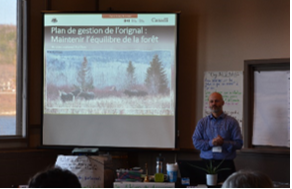
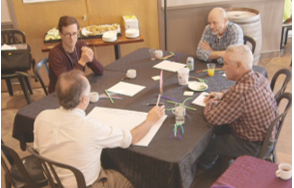
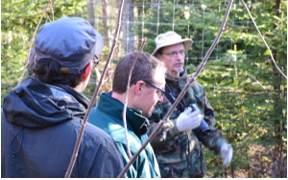
Other meetings took place in different formats. The Forillon National Park advisory committee, which includes a dozen stakeholders from various backgrounds, was also met. At the request of their teachers, two classes of natural sciences students from the Gaspé campus of the Cégep de la Gaspésie et des Îles also received a presentation with discussion.
At the heart of the communication process, the meetings allowed for a personalized, frank and direct approach, rich in information exchange. The feedback and questions received laid the foundation for the development of the majority of the communication tools. They were also used as primary materials to develop the proposals presented to the public during public consultations. Altogether, meetings were favoured as a communication tool since it was essential that people outside of Parks Canada be included in the early stages of communication.
2.3 Media coverage obtained
From April 29, 2019, until the end of the consultation process on March 15, 2020, Forillon National Park conducted three proactive media releases regarding the "Maintaining Forest Balance" project:
The spring 2019 communication was the first ever media release on the high abundance of moose in Forillon National Park. It informed the general public that the moose population of the park was higher than a healthy, balanced forest could usually support. The media release stated that population management methods would be subject to a public consultation process.
A second communication took place in winter 2020 in order to encourage the local and wider Canadian population to share their opinions during the public consultations on both the Forillon National Park Management Plan and the Management Plan for the overabundant moose population.
Shortly thereafter, a third communication was sent to journalists. In addition to reiterating the importance of participating in public consultations, it mentioned, among other things, that the negative impact of the overabundance of moose on certain mountain peaks in Forillon National Park, could now be shown thanks to the analysis of geomatic data, images captured by drone and field visits that took place in late fall 2019. Parks Canada had found that regeneration was almost non-existent due to moose browsing, threatening forest balance. Consultations and impacts were covered by the journalists in the same news story.
In summary, over a period of about a year, there were three media releases. These resulted in about twenty interviews given by Forillon National Park spokespersons and as many mentions on the subject in the media. Most of the news was broadcast by regional media and had a neutral treatment.
|
|
|||
|
Table 1 – Media release: Overabundant moose population in Forillon National ParkForillon (2019-04-29) |
|||
|
Date |
Media |
Title |
Key phrase |
|
2019-04-29 |
CHNC |
[Too many moose in Forillon Park] |
["The overabundance of moose in Forillon Park has led managers to establish a plan to reduce the herd."] |
|
2019-04-29 |
Radio-Canada, Au cœur du monde |
[Overabundant moose population at Forillon National Park] |
["Parks Canada hopes to reduce the density of moose on the territory of Forillon Park to better protect the flora and fauna."] |
|
2019-04-29 |
Radio-Canada |
[News with Sylvie Aubut] |
["The moose population is too high in Forillon Park."] |
|
2019-04-30 |
Gaspésie Nouvelles |
[How do we deal with the surplus of moose in Forillon Park?] |
["The number of moose doubled in Forillon National Park between 2009 and 2017."] |
|
2019-05-01 |
*Bleu FM, Les Midis-Lunchs |
|
|
|
2019-05-01 |
CIMT-CHAU TVA |
[Hyperabundance of moose in Forillon Park] |
["Forillon National Park is struggling with a hyperabundance of moose on its territory. The authorities are now trying to find solutions to rectify the situation."] |
|
2019-05-02 |
Radio Gaspésie |
[Increase in the moose population in Forillon] |
["Following the studies of the last 10 years, the moose population in Forillon National Park continues to increase. It will be higher than what a forest can normally support."] |
|
2019-05-02 |
Télé-Gaspé, À Gaspé aujourd’hui |
[Forillon National Park: moose baby boom] |
["The moose population is doing well, very well and even too well in the park."] |
|
2019-05-07 |
The Gaspé Spec |
Too many moose at Forillon park
|
"Due to an overabundance of moose in Forillon Park management is establishing a plan to reduce the herd and ensure an ecological balance." |
|
Fall 2019 |
**Nature Sauvage |
[Moose in very large numbers] |
["In order to maintain the health of Forillon's forest ecosystem, park authorities are preparing a new moose management plan. Public consultations will begin in fall. Notice to those interested!"] |
|
[ ]: Translation *Live radio interview **Interview given May 2, 2019, for fall release
|
|||
|
|
|
|
|
|
Table 2 – Media Release: Invitation to public consultations (2020-01-31) |
|||
|
Date |
Media |
Title |
Key phrase |
|
2020-01-31 |
CHNC |
[Forillon Park is developing its 2020-2030 master plan] |
["The management plan for the overabundant moose in the park will be discussed, with the ultimate goal of restoring forest balance."] |
|
2020-02-03 |
Télé-Gaspé |
[Forillon National Park: the population will be consulted] |
["Stéphane Marchand [...] gives us details to control the overabundant moose population."] |
|
2020-02-04 |
Radio Gaspésie, Libre-Échange |
[Forillon, a 10-year development plan] |
["On Monday on the Libre-Échange program, we discussed the next management plan for Forillon National Park."] |
|
2020-02-05 |
Radio Gaspésie |
[Forillon Park public consultations] |
["Forillon National Park is inviting the public to share their opinions from February 12 to March 15 in order to develop its Management Plan concerning the overabundance of moose."] |
|
2020-02-05 |
*Gaspésie Nouvelles |
[Public consultations for the 10-year plan at Forillon Park] |
["Parks Canada invites the population to participate in public consultations as part of the renewal of the Management Plan of Forillon National Park, and also for the elaboration on the Management Plan on the overabundant moose population."] |
|
2020-02-13 |
**Radio-Canada, Bon pied, bonne heure! |
[Public consultations at Forillon National Park] |
(Bruno Lelièvre) "A booth yesterday, Isabelle, which was extremely popular was the moose booth. One of the issues is hyperabundance. There are people there to answer questions." |
|
2020-02-17 |
CHNC |
[The hyperabundance of moose receives attention at Forillon public consultations] |
["The hyperabundance of moose in Forillon Park attracted the attention of the hundred or so people who attended the public information sessions on Wednesday and Thursday."] |
|
[ ]: Translation *Gaspésie Nouvelles, a newspaper in paper format, another different article was published on the Web the same day. **This media outlet was on site. |
|||
|
|
|
|
|
|
Table 3 – Media release: Impacts of moose in Forillon National Park (2020-02-04) |
|||
|
Date |
Media |
Title |
Key phrase |
|
2020-02-05 |
*Gaspésie Nouvelles |
[Public consultation for the 10-year vision and moose overabundance] |
["It is now possible to demonstrate the negative impact of the overabundance of moose on certain peaks in Forillon National Park... / Public consultations on the Management Plan for the overabundant moose population will be held at the same time as consultations for the renewal of the Forillon National Park Management Plan."] |
|
2020-02-05 |
Radio-Canada |
[Forillon National Park wants to control its moose population] |
["According to Pierre Etcheverry, signs observed in recent years show that the forest regeneration of the park is suffering. / The public consultation on the Management Plan for the overabundant moose population in Forillon National Park will take place on February 12 and 13."] |
|
2020-02-06 |
CIMT-CHAU TVA |
[Moose overabundance: real conséquences] |
["Drone footage and field visits have shown that forest regeneration is almost non-existent. / [...] public consultations will be held on February 12 and 13 on this very subject."] |
|
2020-02-10 |
Radio Gaspésie |
[Impact of moose overabundance demonstrated by drones] |
["The impact of the overabundance of moose in Forillon National Park was filmed with the help of drones during fall 2019. / Public consultations will take place on February 12 and 13 and it will be possible to complete the survey online until March 15."] |
|
2020-02-14 |
**CBC Québec
|
|
|
|
[ ]: Translation *Gaspésie Nouvelles, online newspaper, another different article was published in the paper version the same day. **Live radio interview |
|||
2.4 Activities offered to visitors in the park
In terms of awareness and education, it was important that visitors have access to relevant information about moose directly in the park. Two talks were prepared for this purpose: "L'orignal sous haute surveillance" [The moose under high surveillance], which was held weekly during the high season, and "L'orignal : maître des lieux, discret de nature" [The moose: master of the site, discreet in nature], a single presentation. A BioBlitz discovery event and guided hikes were added to these outreach efforts.
In total, for all activities combined, more than 500 people were informed about moose in general and made aware of the impacts of this overly abundant ruminant on the park's vegetation during their stay at Forillon National Park. Interpretation is one of the most popular products for visitors, so the activities offered have reached a good number of people in an educational setting, in the middle of nature.
2.5 Web pages
The web pages "Maintenir l'équilibre de la forêt" and "Maintaining forest balance" went live in mid-December 2019, about two months before public consultations. People who wanted to think more about the moose in Forillon National Park could do so by having access to quality content at a time of their choice.
To give them maximum visibility, a shortcut was placed directly on the Forillon National Park home page in the Featured section, which also facilitates quick identification.
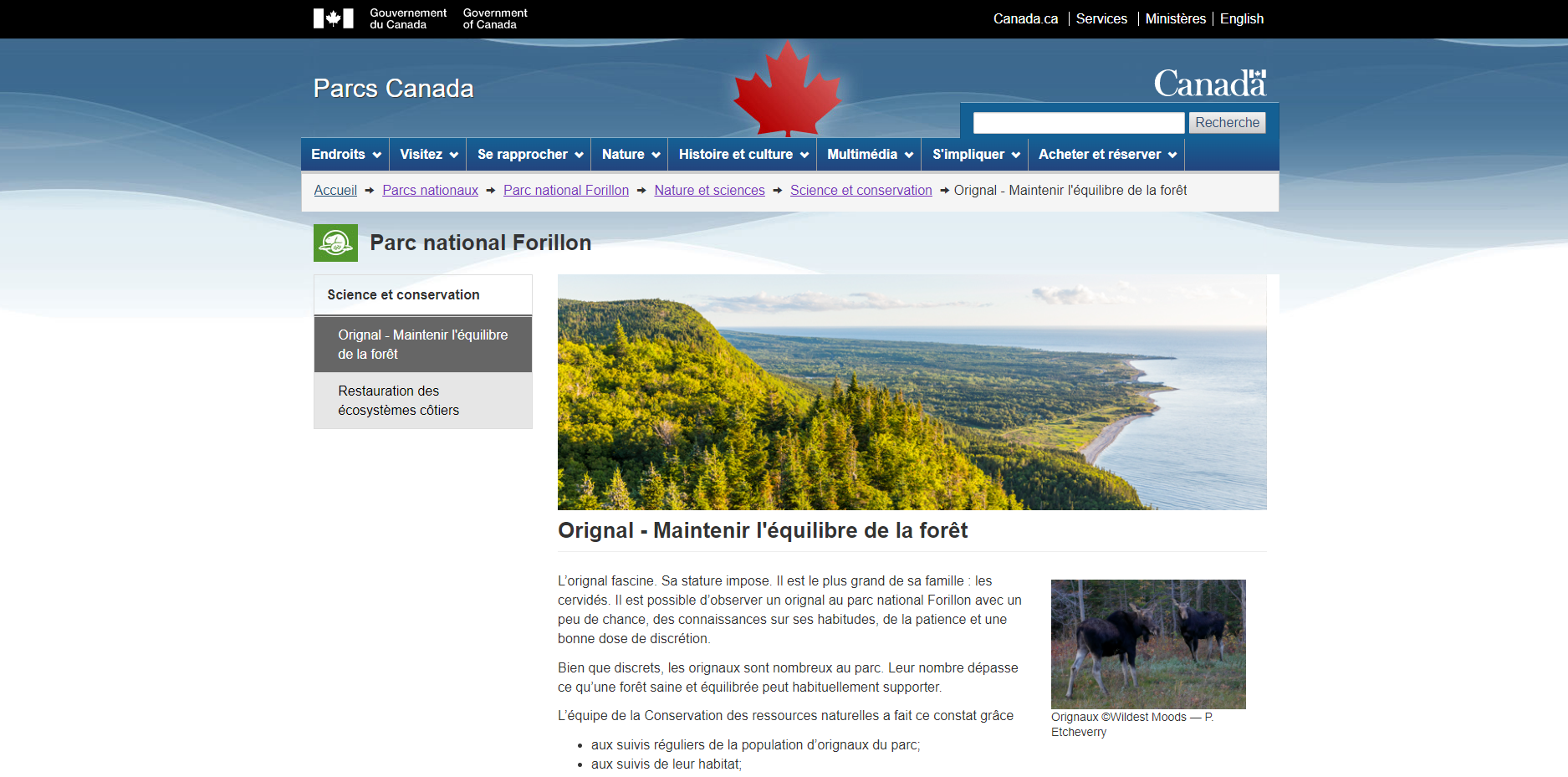
Presented in a "frequently asked questions" format, these web pages explain, among other things, the moose overabundance situation in the park, the causes and consequences. Its content is strongly inspired by the exchanges that took place during the various meetings.
To highlight the research partnership with Université Laval, a brief section on the role of the winter tick in the ecology of moose populations in eastern Canada was added. A hyperlink links to the Tick-Moose-Climate Research Partnership site, which is very informative.
Another section was created with hyperlinks to national parks in eastern Canada that are experiencing the same phenomenon. The Forillon National Park project is inspired by the best practices developed in similar Cape Breton Highlands, Gros Morne and Terra Nova national parks.
From the time the consultations went live until they ended, from December 13, 2019, to March 15, 2020, when the consultations ended, around 250 people (single page views) accessed the web pages. The French page was consulted more. A few other statistics could be derived from this. The average time spent on this page was about two minutes. A quarter of the Internet users came from the city of Gaspé.
2.6 The Year in review – 2019
At the end of December 2019, the Year in review, which is the annual review of significant events of Forillon National Park, devoted two pages to explain the "Maintaining forest balance" project, the communication process undertaken as well as the upcoming steps regarding consultations. A hundred copies of this document were printed and distributed population of Forillon National Park. 8 to employees and partners. It was also available on the Forillon National Park website and was promoted by sending a bookmark to every home and business in the city of Gaspé area.
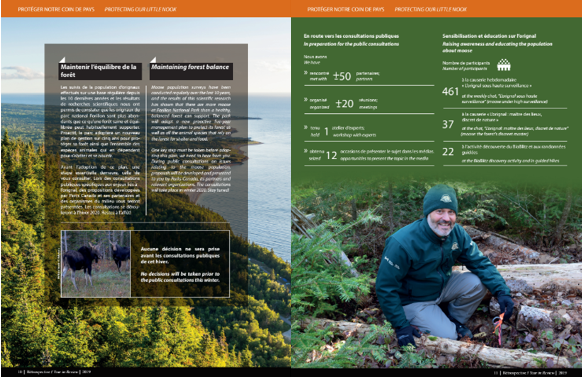
Although it is difficult to determine the number of people who specifically consulted the section on moose, this tool nonetheless illustrates the efforts made by Forillon National Park to multiply the means of communication at various times in 2019-2020 with a view to reaching as many people as possible.
2.7 Promotion of public consultation
As part of the public consultations, a newsletter on the subject was sent to every residence, business and organization in the city of Gaspé area. In addition, a newspaper and radio advertising campaign was orchestrated. All these tools aimed to provide the necessary information so that citizens could form their own opinion and then share it with Forillon National Park.
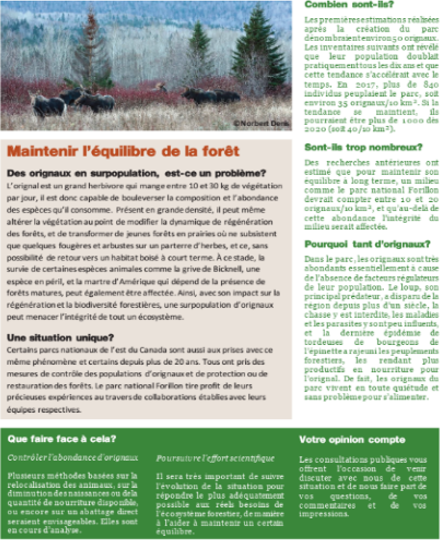
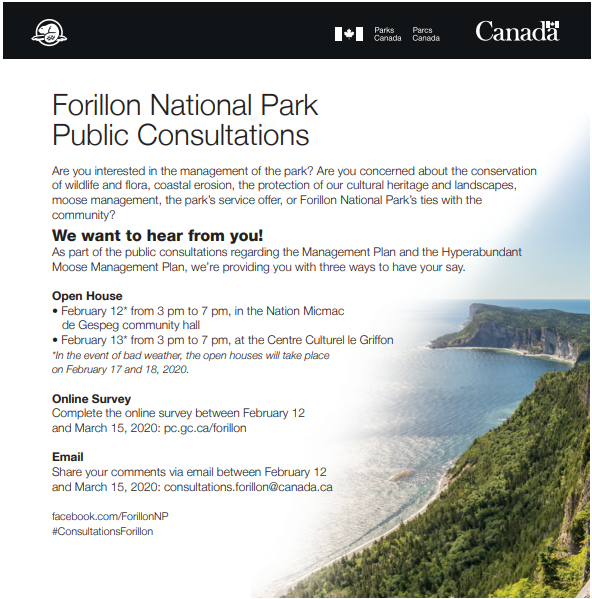
2.8 The information campaign on Facebook
A campaign on Facebook was used to complement the other communication tools. It began in January and ended in March 2020. Prior to the consultation period, it was used to provide brief educational messages about moose while debunking certain beliefs. During the consultations, the posts invited people to participate.
The first part of the campaign went well. The topics were overpopulation, moose feeding, and exclosures, which keep moose out of the fenced area and prevent them from eating the vegetation there. In addition, one post was intended to highlight a collaboration in conservation. It highlighted the ecological corridors that the Nature Conservancy of Canada is building between Forillon National Park and the surrounding forests to make it easier for moose to move around.
In contrast, the next three posts in February, on tick collars, moose impacts, and wolves respectively, went completely off topic. There were several opinions on management measures. For Forillon National Park, it was an opportunity to be seized.
First, commenters were told that Facebook was not among the official means of indicating their preference for any of the management measures. Then, the different ways to participate in the public consultations were explained to them so that their opinions could be compiled. Some people reported that they had made observations contrary to what the park was claiming about moose numbers. They were encouraged to come and share them with the park staff on site during consultations.
Thirteen bilingual posts were published, the first on January 20 and the last on March 3. Each French-language publication had an average of more than 3,700 people reached (saw the publication in their news feed) and nearly 1,000 for each English-language publication. For social network engagement, both languages combined, over 4,100 total interactions (liking, sharing, commenting and clicking on the published link). In active interactions, 125 comments were received and responded to as needed and 125 shares were made. The statistics were taken in August 2020.
The Facebook campaign was wise and a turning point for participation in the public consultations concerning the Management Plan for the overabundant moose population in Forillon National Park. Thanks to them, many people came out to voice their opinions.
2.9 Public consultations
Nearly one hundred people showed up and spoke with Forillon National Park staff on site during the two open house days. It was possible to view a presentation and handle explanatory material (a bag containing the equivalent amount of vegetation consumed by an average adult moose in one day, moose tracks and a reproduction of scat) laid out on a table that served to illustrate certain points. Many participants stayed for over an hour talking with park representatives, focusing on the science and sharing their impressions and their observations of moose.
The participation rate and average time given to each person attest to the fact that not only did participants show up in significant numbers, but they also received quality discussions.
The Micmac Nation of Gespeg was consulted.
To allow all Canadians to participate in the public consultations, an online survey was available from February 12 to March 15, 2020, at pc.gc.ca/forillon. This survey was also published on the Government of Canada's consultation platform. The opinions of 274 respondents were recorded. Most of them came from Gaspé. Finally, a few individuals or organizations chose to send their feedback or submissions to the email address pc.consultations-forillon.pc@canada.ca or by mail.
The variety of ways to provide an opinion or feedback at the public consultations was intended to encourage participation, and the numbers attest to this.
3. Conclusion
The results, both qualitative and quantitative, of each communication tool developed (the information transmitted to the staff of Forillon National Park, the external meetings, the media coverage obtained, the activities offered to visitors in the park, the Web pages, the Year in review - 2019, the promotion of the consultations, the campaign on Facebook and the public consultations) are significant.
The cumulative results indicate that the communication objectives were satisfactorily met. The objective of highlighting Parks Canada research partnerships and collaboration on conservation should be maintained.
It is strongly recommended that communication efforts be continued to ensure continuity of future actions surrounding the Management Plan for the overabundant moose population. In concrete terms, an update of the communication plan and a new action plan should be considered.
- Date modified :
